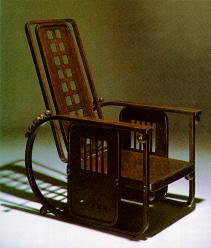
A beechwood chair designed by Josef Hoffmann for the Wiener Werkstätte
c.1905; ht 42in/106.5cm; value code B
FURNITURE
THE WIENER WERKSTÄTTE

A beechwood chair designed by Josef Hoffmann for the Wiener
Werkstätte
c.1905; ht 42in/106.5cm; value code B
1. Is the piece of geometric or linear form?
2. Is use made of ball motifs, perhaps at intersections?
3. Do the decorative motifs include pierced squares or slender rectangular grilles?
4. Is the piece free of integral surface decoration?
5. When made from bentwood, is the piece devoid of angular corners (or are the corners
gently rounded)?
Josef Hoffmann (Austrian, 1870-1956)
Originally trained as an architect, Hoffmann was influenced by Mackintosh (see page) and the Glasgow School. His
notable commissions include the interior of the Fledermaus cafe in Vienna. In 1897 he
founded the Vienna Secession, an association of artists and architects dis-illusioned with
the work of the Viennese Society of Visual Artists.
The Wiener Werkstätte (Vienna Workshops) (1903-32)
Inspired by the attempts of the Vienna Secessionists to bring more abstract and
purer forms to design, Hoffmann founded the Wiener Werkstätte. Associated designers
included Josef Maria Olbrich and Koloman Moser. As well as buildings and furniture, the
group designed silver, glass (see page),
ceramics (see page) and
metalwork.
| Hoffmann's designs Hoffmann designed all kinds of furniture, including tables, chairs and light fittings. His work uses severe, geometric forms rather than the sinuous forms of other Art Nouveau designers. The Sitzmachine (sitting machine), in the main picture, typically combines simple oval and rectilinear forms. This example is adjustable the knobs determine the angle of incline. Others have upholstered backs. This piece is made from beechwood, but Hoffmann often used more costly limed oak, mahogany and ebonized woods. The bases of some of his pieces are covered in beaten brass. Some of Hoffmann's furniture is made in bentwood, that is, laminated or
solid wood steamed and bent into the required curvilinear shape. Hoffmann's bentwood
pieces typically have smooth or gently rounded corners. This simple bentwood table, above,
is an example. It was made to Hoffmann's design by Jacob and Josef Kohn, one of the
largest Viennese furniture manufacturers. Kohn, and another large Viennese firm, Thonet
Brothers, executed the majority of Hoffmann's designs. Unlike many Wiener Werkstätte
designers, Hoffmann took advantage of mass production techniques. |
decoracive motifs. Olbrich's walnut cabinet, entitled Herbst (Autumn), above, is made up of strong symmetrical elements. Decoration is restrained, consisting of panels inlaid in frutwood and mother-of-pearl, and carved lines along the side. The Wiener Werkstätte made several mantel clocks. The strongly geometric
example above, by Josef Urban, is made of such diverse materials as walnut,
silver plate, ivorene, enamel and agate. |